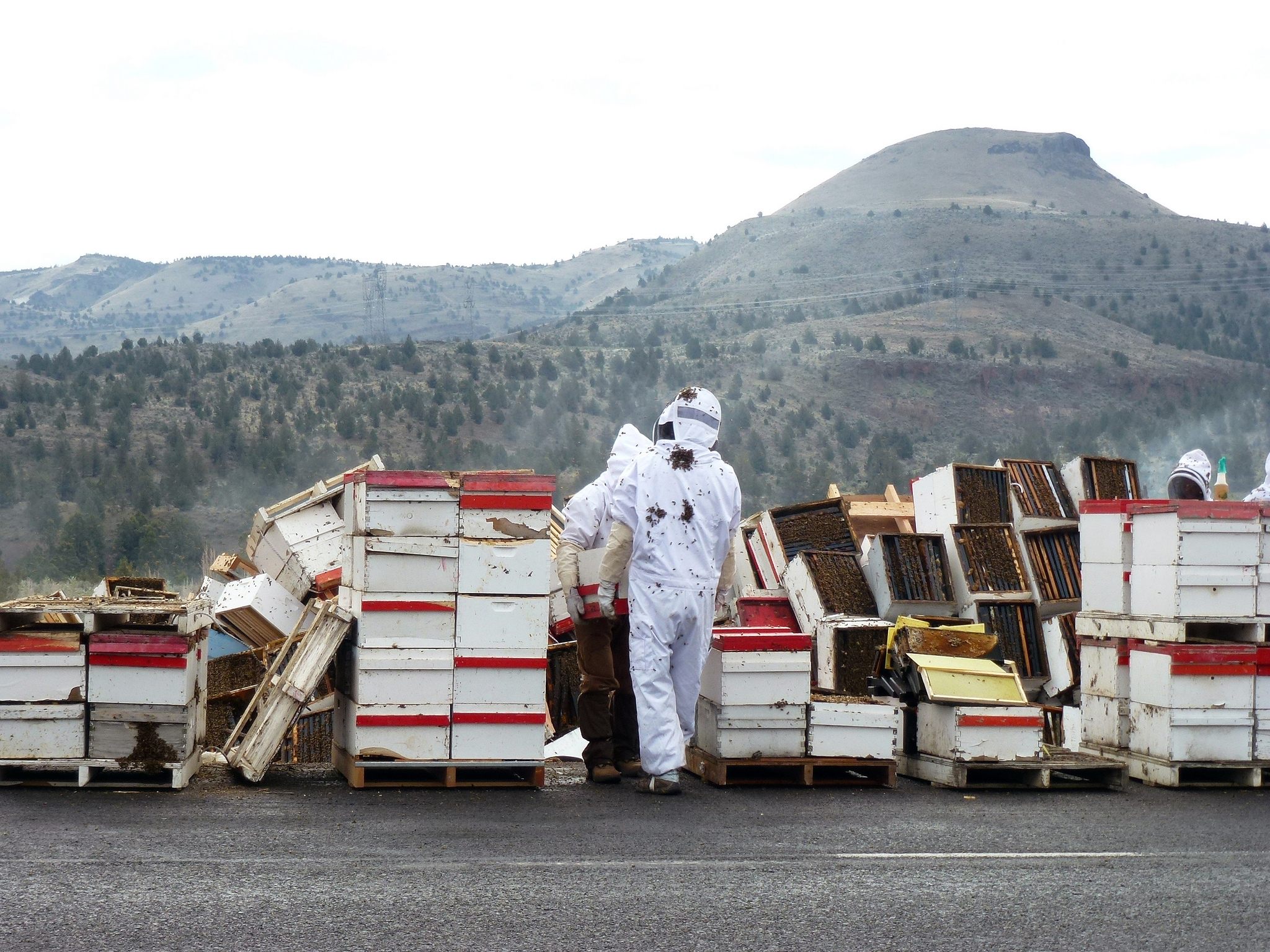The Case Against Honeybees
The buzz around America’s favorite workers grows louder every year. Is it drowning out the real story of our food system?
Honeybees (Apis mellifera) in their hive. (Photo: Mirko Graul/shutterstock.com)
Tucked into a nondescript road verge in Asheville, North Carolina, halfway between a vintage shop and the Moog Synthesizer Factory, stands a roped-off patch of long grass and wildflowers. In it, hibiscus trees drowse in the sun. Clusters of white milkweed bob over the sidewalk. “POLLINATORS AT WORK,” a yellow sign proclaims. A clip art bumblebee hovers alongside the words, wearing a hard hat and kerchief. Under the main slogan, smaller letters: “Let ‘em work. Let ‘em live.” It’s a strange place for a garden, but if you tune out the cars whipping down the I-240 overpass, you can hear it faintly humming.
Walk a little further, and you end up in downtown Asheville—which, on this particular week in late June, is all abuzz for the Pollination Celebration, a bug-based extravaganza put on by local nonprofit Bee City USA. Restaurant tables sport pamphlets telling you whom to thank for what’s on your plate. Shoppers can flit from store to store and, like pollinators, pick up a small reward—a honeybee decal, a spoonful of royal jelly, a honey-whiskey cocktail. There are craft honey tastings, planting parties, and educational talks, and in the window of one clothing store, the mannequins are dressed like moths and monarchs.
Want your own pro-honeybee tour any day of the week? Head to your local grocery store in America, and you’ll see something similar. Emblazoned on tubes of Burt’s Bees chapstick: “Bring Back the Bees.” On boxes of Cheerios: “We Need The Bees.” On bottles of Honeywater: “Why Bees Matter.”
Who could object to such wide-ranging enthusiasm—as American as honey-baked ham?

The pollinator garden in Asheville. (Photo: Cara Giaimo)
A woman named Sarah Bergmann, for one. She doesn’t want to save the honeybee, and she knows how this sounds. “I don’t mean that to be an asshole,” she says apologetically, over the phone from her home in Seattle. Then, she doubles down. “The entire basis of my work is basically: don’t save anything, and certainly don’t save the honeybee.”
A designer by training, Bergmann has spent the past eight years working on something she calls the Pollinator Pathway. As it currently exists, this project is a mile-long swath of connected gardens running through the heart of Seattle. Chock full of native plants, it allows local bugs to travel throughout the city, rather than being islanded off in small wildflower patches.
In Bergmann’s mind, the pathway stretches far further. In a world almost completely bent to the will of humans, redesigning even one mile in service of other living things is an act, for her, with profound implications. “My own individual project is just a vehicle to understand how we might look at larger problems,” she explains—land use, climate change, the biodiversity crisis. If we’re going to mess with landscapes anyway, why not be more intentional about it?

A rendering of the Pollinator Pathway in Seattle. (Photo: Courtesy Mithun)
That’s why Bergmann started this project, and it’s what she wants to talk about. In most cases, though, she can’t: the honeybee gets in the way. She says, “pollinators,” and they hear, “why bees matter.” She says, “we need change,” and they hear, “we need the bees.” “I can’t separate from that story,” she says, the frustration palpable in her voice. Before she says or does anything, she has to bat the darned thing away.
When she was named one of Seattle Magazine’s Most Influential People, in 2013, the photographers asked her to pose in a beekeeping outfit. (She refused.) Enthused community members send her honeybee drawings. Would-be grantees, mistaking her for a honeybee evangelist, pull their funds. After seeing one too many articles with her name in them and a big honeybee picture splashed over the top, she stopped giving interviews. “I was flummoxed trying to explain myself,” she says. “I just felt like I couldn’t get there from here.”
Bergmann isn’t the only one stuck in this story. Ever since it accompanied the first settlers from Europe, the honeybee has embedded itself in America—not only in our landscape, but also in our food system, our values, and our sense of identity. For Bergmann and others imagining a more sustainable future, its takeover of our conservation discourse isn’t just distracting. It might even be dangerous.
That Buzzing Noise

A close up of a Queen honeybee. (Photo: USGS Bee Inventory and Monitoring Lab/Public Domain)
Unless you’ve been hibernating for the last decade, you probably know that honeybees are in trouble. Just in case, though, here’s a refresher: in 2006, huge swaths of worker bees suddenly abandoned their homes, flying off into the woods to die. Apiarists would lift the lids of their hives and find honeycombed ghost towns. “We have one beekeeper in Pennsylvania who had 1200 colonies early in the year and now has 200,” a Penn State bee specialist stated in an early report. “[The disappearances] are dramatic.”
In the years since, this eerie phenomenon, initially dubbed “colony collapse disorder,” continued to decimate hives. Although various fingers have been pointed—at pesticides, parasites, and habitat loss, among other ills—until recently, no one was sure exactly what was to blame. The catastrophe and mystery combined have fueled worldwide concern and awareness. Everyone and their grandfather knows the bees are disappearing.
In some ways, it’s surprising that so many flocked to the honeybee’s cause. The world is a mess. There are plenty of environmental issues currently duking it out for attention, research dollars, and heartstring-tugs. Your average conservation mascot tends to be a charismatic megafauna—large, fuzzy and tailed by adorable, big-eyed young that bear some resemblance to human babies. Honeybees are tiny, stinging, and lay whole duplexes of wriggly larvae, and the factors playing into their disappearance are a shade too complex to argue about at summer barbecues. How did this issue grab so much of the conversation? Where is the J. Crew line for the emerald dragonfly, or the Buzzfeed listicle about noise pollution?

Before and after photos of the Pollinator Pathway. (Photo: Sarah Bergmann)
One hint lies in an oft-cited statistic. Greenpeace, the New York Times, and the Huffington Post will each tell you that a bee is responsible for one out of every three bites of food eaten by humans. Depending on who you ask, this figure is either slightly misleading—all are quoting a statistic that applies to pollinators generally, not just bees—or off by a factor of about nine. But read between the numbers, and a pattern of values emerges.
As Bergmann explains, honeybees these days aren’t just mascots. They’re not really even wild animals anymore. About half a century ago, she says, “we started to use the honeybee for a different purpose”—pollinating American crops. These days, they’re flown, shipped and trucked from their homes to stateside fields, stacked in boxes and given “pollen patties” for the road. They hit up different regions like a rock band on the road: February in Sacramento for almond season, Texas in May to fix up the cantaloupe crop, summer in Illinois for pumpkins. (Monsanto calls this the “Pollination USA Tour.”) They are now a bonafide ecosystem service, less like “the polar bear” or “the whales” and more like California’s dwindling water supply.
When honeybees vanish, then, they’re not just disappearing; they’re abandoning their posts. The real victim is us.
All but five to ten percent of American honeybees work for the man in this way. Honeybee pollination is a $15 billion industry, and in the words of one USDA report, honeybees succor flora “from alfalfa to zucchini.” Now that they’re in trouble, this market share has helped them corner the conversation, too. “A lot of this narrative is quite aggressive,” says Bergmann. “In many ways, this conversation is being shaped as much as it’s being explored.”
The narrow dialogue that results, Bergmann argues, obscures the real root of the issue: America’s farmlands are much simpler than they once were. This is, as we are discovering, a problem. Because so much of the world is already in the early stages of a similar species downsizing, it’s also a useful harbinger. “What we’re seeing with the honeybee is an endpoint of complete lack of biodiversity,” says Bergmann. “It’s like a future but now.”
The Long History of Worker Bees
To understand how we ended up in this future, we have to look to the past. For pretty much all of human history, honeybees have gotten a really good rap. Ancient Egyptians believed that “working bees” were born from the tears of the Sun God Ra, and granted their pharaohs an additional honorary title, “The Beekeeper.” Honeybees appear in the Quran, during which Allah inspires them to land lightly and labor tirelessly. In book IV of his Georgics, the epic Roman poet Virgil spends scores of lines rhapsodizing over bees, in which he sees many of the best qualities of civilization: foresight; hard work; governance; loyalty. “They alone hold children in common: own the roofs of their cities as one, and pass their life under the might of the law,” he writes. “They alone know a country, and a settled home.”

A honeybee at work. (Photo: Anne Reeves/CC BY-ND 2.0)
The British, too, found honeybee hives to be full of useful metaphors. In 1609, Charles Butler, apiarist to Queen Elizabeth I, published the first ever English-language beekeeping book, The Feminine Monarchie. As the title suggests, this work was about more than frame assembly and swarm prediction. In it, Butler popularized the knowledge that the queen bee is female, and he wasn’t shy about hammering home the “natural” societal order suggested by this fact. “The Queene is a faire and stately Bee,” he writes—and who better to surround such a queen than a posse of devoted workers? Bees “may well be said to have a Commonwealth… They work for all, they watch for all, they fight for all,” he continues. “And all this under the government of one Monarch, of whom above all things they have a principal care and respect, loving, reverencing, and obeying her in all things.” A lesson clearly meant for people as well as bugs.
Butler also introduced England to the idea of “drones”—those bees that don’t sting, pollinate, or gather nectar, and exist solely to mate with the queen. In Butler’s reading, these bees are nothing but “idle companions, living by the sweat of others’ brows.” In the years after Elizabeth I’s death, Britain suffered extensive crop failures, and thousands of peasants and migrant workers lost their livelihoods. Suddenly they, too, were idle, though not by choice.

The opening pages of Charles Butler’s The Feminine Monarchie or The Historie of Bees. (Photo: Hathi Trust/Public Domain)
As historian Tammy Horn details in her 2005 book, Bees in America, by defining the drone, Butler “inadvertently provided a convenient analogy for seventeenth-century English writers, clerics, and politicians.” England was getting overcrowded. These human drones, massing threateningly, had to go—but where? The answer, of course, was the New World, where proper use of nature’s bounty would turn the idle, stingless masses into workers. As clergyman Robert Grey put it in an exodus-exhorting sermon, those suffering at home would do well to “fly abroad like the bee to gather the pleasures and riches of the earth.”
So, like many before them, the American colonists began thinking of themselves as bee-like. But as Americans tend to do, they took the metaphor even further. With no actual honeybees waiting for them overseas, the settlers sent for whole hives of them, which they then raised for wax and honey (“As soon as colonists imagined that America could be a ‘land of milk and honey,’ they set in motion the events to make [it] so,” writes Horn). Their new companions reminded them to work hard and stick together. Even Captain John Smith used drone-based name calling to motivate his fellow Jamestown settlers.

Hives are loaded onto a tractor-trailer where they will be transported from South Carolina to Maine to pollinate blueberries. (Photo: Pollinator/CC BY-SA 3.0)
According to Horn, this bee-based rhetoric inspired many of the British settlers’ most emblematic attributes—their habit of grabbing up “unused” land; their tendency to downplay “less organized” civilizations. During the American Revolution, newly minted Patriots put beehives on the short-lived $45 bill, and started calling British officials “drones.” There was even a popular story in which bees saved a young female war messenger by attacking the Redcoats. By this time, the two groups were linked in a different way: “The bees have generally extended themselves into the country, a little in advance of the white settlers,” wrote Thomas Jefferson in Notes on the State of Virginia. “The Indians therefore call them the ‘white man’s fly.’” (The sight of these harbingers became its own kind of sting: “As they discover the bees,” reported St. Jean de Crévecoeur, “the news of this event spreads sadness and consternation in all minds.”)
Over the next two centuries, the white man and his fly took over the whole continent. Explorers carted them across the Rocky Mountains, sent them ahead over the open prairie, and shipped them by water to the West Coast. Throughout, honeybees remained a rhetorical tool, even as this century’s agricultural shifts made them an economic necessity, too. “No two values have been so highly regarded since colonial days than industry and thrift,” sums up Horn, “[and] no better symbol represents these values than the honeybee.”
‘The Honeybee Industrial Complex’
You don’t have to be a 17th-century British settler to admire honeybees. When it comes to thrift and industry, they are, indeed, relentlessly creative. Those hexagonal combs aren’t just cool-looking: by building in that shape, they achieve the largest possible area using the least possible wax. When they switch societal roles—say, from worker bee to larva nurse—their brains literally change.
However, honeybees aren’t only critters that can pollinate. In most individual cases, they aren’t even the best bugs for the job. Studies show that, compared to other pollinator species, honeybees are downright inefficient. They can’t pull off fancy moves—like buzz pollination, in which a particular wing vibration releases a pollen payload, a strategy employed by tomatoes, potatoes, and blueberries. As a result, plenty of plants, from carrots to coconuts, can’t use honeybees at all, and rely instead on helpers that evolved alongside them—flies, moths, or one of the 4,000 types of bees actually native to the United States.
But those creatures don’t tend to hang out on modern farms, which are designed for efficiency, not naturalism. “Domesticated landscapes bloom all at once, and die all at once. If you’re a pollinator, that means that you’ve got a ton of food, and then you have no food”—not a sustainable living situation, explains Bergmann. “We’ve created a system where we need to bring in an outside pollinator. And the honeybee, being stackable, is what we selected.” Basically, they’re just ok, but portable, and like McDonalds, this has been enough to let them corner the market.

The scene of a truck spill in Oregon, where a semi-trailer crashed that was carrying nearly 400 hives for fruit orchard. (Photo: Oregon Department of Transportation/CC BY 2.0)
As a result, honeybees are spread so thin that scientists think they’re working themselves to death. After years of ecological head-scratching, a 2014 paper pinned the honeybee crisis on what the authors described as “chronic exposure to multiple interacting stressors”—parasites, diseases, pesticide exposure, constant touring. Colonies could handle one of these at a time, but all together, it’s just too much. When we turned the honeybee’s industriousness into industry, we failed to build in a sufficient health care plan.
In the meantime, the same things that are traumatizing the bees are also messing with those native pollinators that might otherwise take the pressure off. Scores of species of native bees, moths, butterflies, and flies are struggling, mowed out of their homes, poisoned by chemicals, and felled by introduced pests and diseases. “For a larger and larger part of our country, it is hard to access anything resembling a functioning ecosystem,” says Aaron Hirsh, a hobbyist beekeeper and a biologist at the University of Colorado at Boulder. This fact is well-illustrated by one of the newest troubling honeybee facts—it is essentially impossible to produce organic honey in the United States, because the bees can’t go anywhere without running into pesticides.
Looked at head-on, these problems are not so much a result of the honeybees’ decline as a symptom of their ascendance. Without a stackable, shippable, one-size-fits-all pollinator, we would need to work around native bugs’ needs. We would have had to leave them some diverse, livable habitat, in and among the identical rows of crops. The honeybee has lent us “the unfortunate capacity—in the short term—to do without little fringes of nature,” says Hirsh. “Without the honeybee industrial complex, you would have to keep those bits around.” We used the bees to build a flawed system, and now that they’re collapsing, it is, too. We don’t have to save the honeybee—we have to save our land from honeybee dependence.

Studying honeybees, 1970. (Photo: US Government/Public Domain)
Those who could do this at a large scale are catching on somewhat. Last year, for example, the White House released a health-promotion plan aimed at “Honey Bees and Other Pollinators”, promising to look into the pesticide problem and to encourage the planting of “pollinator-friendly seed mixes” within croplands. But, Hirsh says, such efforts aren’t enough. “Imagine what the landscape would look like if [corn and soybean] subsidies went instead to pay for a national network of natural refugia,” he says—in other words, a pollinator pathway.
In the meantime, a plan like Bergmann’s allows for regular citizens to pick up the slack. “To care about nature, people need a way in,” says Hirsh. “Here I don’t mean only a path that takes them into the woods. I mean a mental way in, something to pay attention to. Birdwatching does this. Fishing does it. So does the Pollinator Pathway.” If the current model of industriousness and thrift requires honeybees for hire and government-subsidized monocrops, a newer one might make more room for two layers of activity—on the one hand, high-level planning and intention, and on the other, communities, shovels, and sweat. People could turn, once more, from drones to workers. And all pollinators—not just honeybees—would be able to do their jobs again, too.
‘They Had Me At Hello’

Detail of a bee hieroglyph from the tomb complex of Senusret I. (Photo: Keith Schengili-Roberts/CC BY-SA 2.5)
Bee City USA’s tagline is “Making the World Safer for Pollinators.” It is one of a growing number of national and local groups dedicated to helping these useful insects thrive. Over its four-year tenure, the organization has recruited two dozen “bee cities,” from Fort Bragg, California to Washington D.C., that have promised to hold educational events and encourage native planting. Like Asheville’s window stickers and upbeat garden signs, most of Bee City’s press materials are sunny, even in the face of impending doom. “Each city is really celebrating pollinators,” says Phyllis Stiles, the organization’s founder and director. “We try to make it a happy thing.” And honeybees make her happy: “how they function as a superorganism, and how altruistic they are… from the beginning, I was just smitten,” she says. “It’s like Jerry Maguire. They had me at hello.”
Now though, a few years into the relationship, even Stiles thinks honeybees are a bit overrated. “[Native pollinators] are not allowed to shine like they should be shining,” she says. “There is a whole industry out there devoted to agriculture as it’s run in America, and they want you to just think about the honeybee. There’s a machine out there that’s promoting that idea.”
But Bee City’s goal isn’t to fight machines—it’s to get people interested. Thus the honeybee decals, honey-whiskey cocktails and pro-honeybee rhetoric common to so many endeavors that purport to be more generally pollinator-focused. Honeybees, Stiles says, are a “gateway pollinator.” “We’re using her star power to draw people into our mission,” she says. In her view, you can hit ‘em with the complicated stuff after they’ve already been stung.
Avoiding the Honey Pots
The Ancient Greeks, who made nectar the official drink of Mt. Olympus, have a particular myth about Aristaeus, a god-shepherd who was the first to tame the honeybee. In the Bulfinch’s Mythology version of this tale, Aristaeus inadvertently kills the nymph Eurydice, and returns to his hives to find that her vengeful sisters have murdered all of his bees. On the advice of another nymph, Aristaeus sacrifices four bulls and four cows; when he returns to their bodies nine days later, a brand new swarm has arisen from their carcasses.
This story likely sprouted from some nearsighted Greek bard making assumptions about a bunch of flies. But after listening to Bergmann, it seems allegorical, even prescient—the long-lost honeybees, killed by lack of foresight, only rising again from the ashes of agriculture.

Brueghel the Elder’s The Beekeepers and the Birdnester, c. 1568. (Photo: Public Domain)
To Bergmann, the honeybee is less mascot than distraction. Sure, with every themed week and community workday, sponsored by honeybee-happy causes, a few more patches of native plants are added to America’s landscape. But Bergmann’s Pollinator Pathway is still only a mile long. “I’m not moving forward with the project until it can be taken care of forever,” she says. She might be able to drum up more immediate support by giving into some of the honeybee narratives, but history makes her wary of this, too: “Right now honeybees are the flavor of the day,” she says. “What’s going to happen in two years when we’re not so interested in them anymore?”
The honeybees, in the short term, would be fine—thanks to their agricultural importance, they’re in no real danger of leaving us for good. But the support they’ve drummed up—all those humans willing to plant and picket for them—might move onto the next thing, trapping us all in a landscape that looks very similar to the one that got us into this mess.
In a world where our interest can make or break the survival of a species, Bergmann says, it no longer makes sense to work at the species level—to choose what to save based on whether or not we have trained it to feed us. Instead, she says, we have to understand the extent of our own power, and use it to design better. Humans took a bug across the ocean and used it to reshape an entire continent. “We need to recognize we are a major ecosystem,” she says. If we wanted to, we, too, could become an ecosystem service, rather than perpetual, ever-needy clients. Think of it: she says. “Humanity could become a host that supports a diversity of life.”
If history is any guide, America will always be fascinated by honeybees. But by trying to save them, we’ve really been harping on that old question—what they can do for us. Maybe it’s time, finally, to ask what we can do for them.
Gastro Obscura covers the world’s most wondrous food and drink.
Sign up for our regular newsletter.


































Follow us on Twitter to get the latest on the world's hidden wonders.
Like us on Facebook to get the latest on the world's hidden wonders.
Follow us on Twitter Like us on Facebook